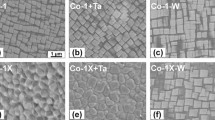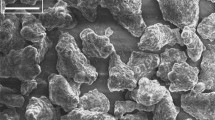Abstract
High-temperature oxidation studies on nickel-based superalloys have reportedly used weight change measurements to assess the overall oxidation kinetics. In this study, oxidation experiments were conducted under laboratory air from 0 to 10 h at 1050 and 1100 °C in the furnace to investigate the oxidation kinetics of Haynes 282 and Inconel 718 nickel-based superalloys. As observed, Haynes 282 superalloy displayed a linear/quasi-parabolic oxidation behaviour at both test temperatures with (n = 0.65) at 1050 °C and (n = 0.68) at 1100 °C. Notably, the best-fit for Inconel 718 superalloy at 1050 °C after 10 h’ exposure was found to be non-linear and closer to parabolic and/or cubic oxidation behaviour with n = 0.37. However, the best-fit for this same alloy at 1100 °C was observed to be linear/quasi-parabolic with (n = 0.61) after 10 h’ exposure. The morphology and elemental compositions of the surface oxides formed after the oxidation experiments were assessed by scanning electron microscopy (SEM) and X-ray energy dispersive spectroscopy (EDS). Inconel 718 superalloy displayed a relatively slow oxidation kinetics over Haynes 282 at the 1050 °C test temperature under the same experimental conditions. Response surface methodology (RSM) was used to analyse the experimental data and generate regression models for predicting specific weight change in Haynes 282 and Inconel 718 superalloys. ANOVA was used to evaluate the fitness and adequacy of each selected 2FI model. The models’ predictive power was validated based on the close agreement (over 99% R2 values) between the predicted and actual mean specific weight change.










Similar content being viewed by others
Abbreviations
- ANOVA:
-
analysis of variance
- RSM:
-
response surface methodology
- CV:
-
coefficient of variation
- CL:
-
confidence level
- SD:
-
standard deviation
References
Weng F, Yu H, Chen C, Wan K (2015) High-temperature oxidation behavior of Ni-based superalloys with Nb and Y and the interface characteristics of oxidation scales. Surf Interface Anal 47(3):362–370
Ostrovskaya O, Badini C, Baudana G, Padovano E, Biamino S (2018) Thermogravimetric investigation on oxidation kinetics of complex Ti-Al alloys. Intermetallics 93:244–250
Eliaz N, Shemesh G, Latanision RM (2002) Hot corrosion in gas turbine components. Eng Fail Anal 9:31–43
Pérez-González FA, Garza-Montes-de Oca NF, Colás R (2014) High temperature oxidation of the Haynes 282 nickel-based superalloy. Oxid Met 82:145–161
Cruchley S, Evans HE, Taylor MP, Hardy MC, Stekovic S (2013) Chromia layer growth on a Ni-based superalloy: sub-parabolic kinetics and the role of titanium. Corros Sci 75:58–66
Park SJ, Seo SM, Yoo YS, Jeong HW, Jang H (2015) Statistical study of the effects of the composition on the oxidation resistance of Ni-based superalloys. J Nanomater 16(1):256
Pike LM (2008) Development of fabricable gamma-prime (γ′) strengthened superalloy. In: Roger CR, Kenneth AG, Pierre C, Timothy PG, Michael GF, Eric SH, Shiela AW (eds) The Minerals, Metals, and Materials Society (TMS), Superalloy 2008, pp 191–200
Yang Y, Thomson RC, R. C. (2014) Microstructural evolution in cast Haynes 282 for application in advanced power plants. In: Gandy D, Shingledecker J (eds) Advances in materials technology for fossil power plants: Proceedings from the Seventh International Conference (EPRI 2013), 22nd–25th October 2013, Waikoloa, Hawaii, USA. ASM International, 143–154
Sharman ARC, Amarasinghe A, Ridgway K (2008) Tool life and surface integrity aspects when drilling and hole-making in Inconel 718. J Mater Process Tech 200:424–432
Zhang HY, Zhang SH, Cheng M, Li ZX (2010) Deformation characteristics of δ phase in the delta-processed Inconel 718 alloy. Mater Char 61:49–53
Belan J (2015) High frequency fatigue test of IN 718 alloy–microstructure and fractography evaluation. Metalurgija 54(1):59–62
Chen YC, Liao YS (2003) Study on wear mechanisms in drilling of Inconel 718 superalloy. J Mater Process Tech 140:269–273
Thomas A, El-Wahabi M, Cabrera JM, Prado JM (2006) High temperature deformation of Inconel 718. J Mater Process Tech 177:469–472
Kennedy RL (2005) Allvac 718PlusTM, superalloy for the next forty years. In: Loria EA, TMS (The Minerals, Metals and Materials Society (eds) Superalloys 718, 625, 706 and derivatives 2005
Chicardi E, Córdoba JM, Gotor FJ (2016) Kinetics of high-temperature oxidation of (Ti, Ta)(C, N)-based cermets. Corros Sci 102:168–177
Butler TM, Chaput KJ, Dietrich JR, Senkov ON (2017) High temperature oxidation behaviors of equimolar NbTiZrV and NbTiZrCr refractory complex concentrated alloys (RCCAs). J Alloys Compd 729:1004–1019
Zou D, Zhou Y, Zhang X, Zhang W, Han Y (2018) High temperature oxidation behavior of a high Al-containing ferritic heat-resistant stainless steel. Mater Charact 136:435–443
The University of Manchester (2010) In: Cottis RA et al (eds) Shreir’s corrosion, vol 1, 4th edn. Elsevier Ltd., Amsterdam, Netherlands
Smith MM (2013) Comparative oxidation study of un-coated and coated CMSX-4 and CMSX-486 single crystal superalloys. Masters’ Thesis, University of Manitoba, Winnipeg, Canada
Tan Q, Mo N, Lin CL, Jiang B, Pan F, Huang H, Atrens A, Zhang MX (2018) Improved oxidation resistance of Mg-9Al-1Zn alloy microalloyed with 60 wt ppm Be attributed to the formation of a more protective (Mg, Be) O surface oxide. Corros Sci 132:272–283
Olivares RI, Stein W, Marvig P (2013) Thermogravimetric study of oxidation-resistant alloys for high-temperature solar receivers. J Miner Met Mater Soc 65(12):1660–1669
Peraldi R, Monceau D, Pieraggi B (2002) Correlations between growth kinetics and microstructure for scales formed by high-temperature oxidation of pure nickel. II. Growth kinetics. Oxid Met 58(3–4):275–295
Mäkelä M (2017) Experimental design and response surface methodology in energy applications: a tutorial review. Energy Convers Manag 151:630–640
Fatemi SA, Ashany JZ, Aghchai AJ, Abolghasemi A (2017) Experimental investigation of process parameters on layer thickness and density in direct metal laser sintering: a response surface methodology approach. Virtual and Physical Prototyping 12(2):133–140
Carter LN, Essa K, Attallah MM (2015) Optimisation of selective laser melting for a high temperature Ni-superalloy. Rapid Prototyp J 21(4):423–432
Hassanpour H, Sadeghi MH, Shajari S, Emami M (2011) Empirical modeling and analysis of surface roughness in milling process of nickel-based super alloy Nimonic 115 through response surface methodology. In: Advanced Materials Research, vol 325. Trans Tech Publications, pp 430–435
Garg MP, Kumar A, Sahu CK (2017) Mathematical modeling and analysis of WEDM machining parameters of nickel-based super alloy using response surface methodology. Sādhanā 42(6):981–1005
Lu X, Wang F, Wang X, Si L (2018) Modelling and optimisation of cutting parameters on surface roughness in micro-milling Inconel 718 using response surface methodology and genetic algorithm. Int J Nanomanuf 14(1):34–50
Bodude MA, Nnaji RN, Osoba LO (2018) Comparative studies on the high temperature oxidation behaviour of Haynes 282 and Inconel 718 nickel-based superalloys. Paper presented at the 13th Unilag Annual Research Conference and Fair, University of Lagos, Lagos, Nigeria. In press: Unilag Journal of Med., Sci. & Tech. (UJMST)
Augustyn-Pieniążek J, Zapała R (2011) The studies of scale surface produced on outer diffusion layers. Arch Foundry Eng:11
Fernandes SMDC, Correa OV, Ramanathan LV (2008) Oxidation and erosion-oxidation behavior of steels. Mater Res 11(1):43–46
Acknowledgments
The authors are grateful to Prof. A. O. Ojo of the Department of Mechanical and Production Engineering, University of Manitoba, Canada, for the provision of test materials to support this study. Special thanks to the Management and staff of MIDWAL ENGINEERING (Metallurgical Engineers and Testing Laboratory), Lekki, Lagos, Nigeria for their technical assistance.
Author information
Authors and Affiliations
Corresponding author
Additional information
Publisher’s note
Springer Nature remains neutral with regard to jurisdictional claims in published maps and institutional affiliations.
Rights and permissions
About this article
Cite this article
Nnaji, R.N., Bodude, M.A., Osoba, L.O. et al. Study on high-temperature oxidation kinetics of Haynes 282 and Inconel 718 nickel-based superalloys. Int J Adv Manuf Technol 106, 1149–1160 (2020). https://doi.org/10.1007/s00170-019-04290-0
Received:
Accepted:
Published:
Issue Date:
DOI: https://doi.org/10.1007/s00170-019-04290-0




